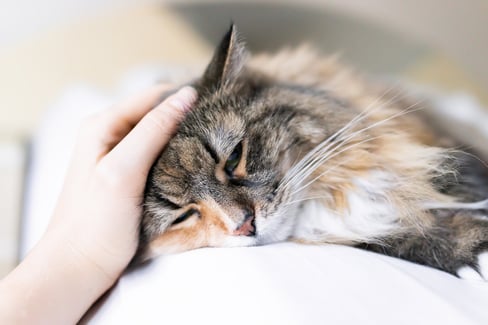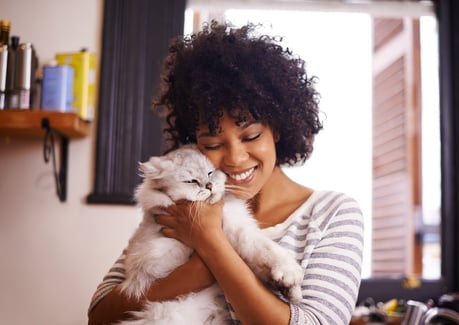Table of Contents
As loving cat owners, it can be distressing to watch your once nimble and active feline struggle to move or play due to joint pain. Though masters of masquerading their true feelings, there are ways to remove the mask and spot a cat in pain:
- Not eating (this is a big one!)
- Vocalization, like hissing or growling in addition to typical meows
- Hunched posture
- General lethargy
- Showing signs of aggression or change in personality
Once you identify that your cat is in pain, managing that pain and providing them with relief is essential.
In this article, we will take a look at cat pain management options, remedies for cat joint pain including use of a cat supplement, and how best to support your furbaby when they are not feeling their best.
What is Recommended to Give a Cat for Joint Pain?
Pain in a cat’s joints can be caused by a variety of factors, including injury, trauma, or degeneration of the joint itself.
General Cat Hip and Joint Supplements
As a preventative measure, it’s best to start giving your cat joint supplements as soon as possible. TRI-ACTA for pets is a great option for regular preventative care. However, if your cat is already suffering the effects of arthritis or other degenerative joint conditions, TRI-ACTA H.A. for pets has the same ingredients as TRI-ACTA, with the addition of hyaluronic acid. This acid improves the viscosity of the synovial fluid in joints for enhanced healing and the highest level of joint protection.
TRI-ACTA H.A. for Pets
Our maximum strength formula is optimally designed to accelerate the formation of cartilage, minimize inflammation, expedite the healing process, and improve joint conditions.

Cat Joint Supplements Arthritis
Cat arthritis is a chronic and painful condition that causes inflammation and degeneration of cat joints. Arthritis affects between 70%-90% of cats over 12 years of age. It is a progressive condition that worsens with time. It leads to the breakdown of joint cartilage, causing the rubbing together of cat bones, specifically their joint bones. This can be extremely painful for a cat and cause lameness, limping, and swelling.
Arthritis can develop due to a ligament tear, conditions like Lyme disease, traumatic injury, infection, or due to a congenital defect.
General joint supplements, like TRI-ACTA H.A., can be given to cats that suffer from arthritis to help lubricate their joints and make them more comfortable. Over time, the symptoms of the disease may lessen because essential natural joint lubricants, like glucosamine and the viscosity of the synovial fluid, are enhanced by the supplement.
Depending on the severity of the arthritis your cat is experiencing and their pain level, your vet may also recommend using anti-inflammatory medications.
How Can a Cat Joint Toy Help With Pain Management?
A cat joint toy can administer catnip to cats in pain. Catnip is good for de-stressing and relieving anxiety in cats.
The trait that is responsible for your cat’s crazy response to catnip typically develops when your cat is between three and six months old. Until the “catnip trait” has developed, your cat won’t respond to the nepetalactone, the ingredient in catnip that causes your furball to go wild.
Some cats may not even have a reaction to catnip at all since the sensitivity to the herb is hereditary! If your kitty doesn’t react to catnip, don’t worry, there’s nothing wrong with your furbaby, they’re just lacking the catnip gene.
For kitties that do love the ‘nip, catnip stimulates the brain to release chemicals associated with improved mood and happiness. The effects of catnip are periodic, meaning they occur in short-term episodes like 5 to 10 minutes, and the cycle is repeated every so often as your cat consumes more of the herb.
The best way to administer catnip is by sprinkling it on a joint cat toy or your cat’s scratching pole.
Benefits of a catnip cat joint toy includes:
- Encourages movement, which promotes blood circulation and relieves aches
- Helps anxious cats relax in new environments.
- Offers temporary pain relief with few side effects like vomiting. This occurs when catnip is consumed in large quantities
Even if your cat doesn’t love catnip, playing with them using cat toys is essential. Through play, they activate and stretch their joints, strengthening them and ensuring they stay healthy. Just like humans are prescribed physiotherapy to recover from joint-related injuries, cats can benefit from exercising their joints in the same way.
Of course, you don’t want to go overboard with playtime, especially if your cat suffers from arthritis or other joint issues or is recovering from an injury. Your vet can give you playtime recommendations, but it’s best to avoid anything with high intensity, like using a laser pointer or playing fetch. Instead, using a wand toy or other toy where the intensity of play can be somewhat controlled by you is the best.
Is Cat Joint Medicine Safe for Pain Management?
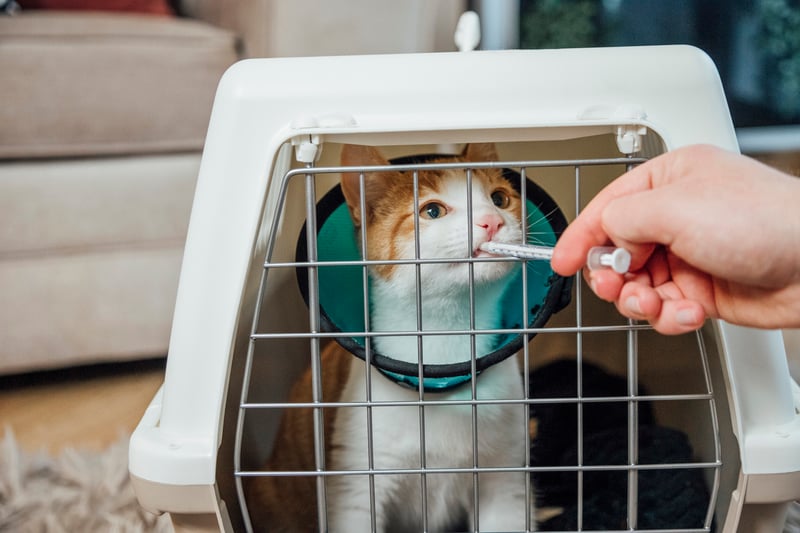
The truth is that cat pain management can be difficult because a majority of painkillers given to other pets, like dogs, are dangerous and toxic to cats. A thorough examination by the vet can help them determine pain-safe pain management options for your cat.
Never give your cat over-the-counter medication without a vet’s approval. Call your vet immediately if you suspect your cat has swallowed un-prescribed painkillers.
Different types of cat pain management medication options can relieve a cat in pain, i
|
Cat pain medication |
Description |
|
Prescription Non-steroidal Anti-inflammatories (NSAIDs) |
|
|
Opioids |
|
|
Steroids |
|
Ingredients to Look For in Cat Hip and Joint Supplements
Good quality cat hip and joint supplements can be hard to find if you don't know what to look for. Our recommendation is always to scan the brand label for filler and additive-free supplements that are made with 100% pure active ingredients. This means you are getting value for money while at the same time giving your feline pal the best quality supplements to help keep their joints healthy and strong.
TRI-ACTA H.A. for pets is one such supplement. It is made with high-quality pharmaceutical-grade ingredients so you can be sure that every ounce of TRI-ACTA delivers pure therapeutic value for your cat.
TRI-ACTA H.A. for Pets
Our maximum strength formula is optimally designed to accelerate the formation of cartilage, minimize inflammation, expedite the healing process, and improve joint conditions.

In addition, we have put together a list of ingredients that should feature in any good quality supplement worth your hard-earned coin. Here is a more detailed description of the ingredients to look for in cat hip and joint supplements
|
Ingredient |
Benefit |
|
Glucosamine |
|
|
MSM |
|
|
Chondroitin |
|
|
Hyaluronic Acid |
|
Cat Hip & Joint Pain Signs to Watch Out For
Though your kitty may try to hide their pain, there are tel-tale signs that can tell you all is not well with your furbaby. It is important to watch out for signs that could indicate a cat is in pain.
Lameness
Temporary loss of mobility or lameness is usually one of the first signs of a cat that’s in pain. They favor the affected limb over the others and opt not to touch the ground with it. It is common for a cat to have difficulty moving, and you might catch them trying to hop on three paws.
Lameness can be caused by a joint dislocation, fracture, ligament sprain, or strain. The degree of lameness also depends on the severity of the injury.
Limping
If your cat has lost some mobility in a limb, they might start limping to avoid putting pressure on the injured leg. A cat limping is an obvious sign that they are in pain which might be aggravated by movement or dragging of the affected leg.
If your cat is limping or their gait is off, you can gently examine the limb for signs of injury or an open wound.
Excessive Vocalization
Sometimes, when a cat is experiencing excruciating pain, it might vocalize it with a lot of yowling or meowing. A cat that is excessively meowing should not be ignored; it is often best to head over to the vet.
Joint conditions like arthritis and osteoarthritis can be extremely painful for your cat. Once the vet diagnoses, they will recommend the best cat pain management options for your feline buddy.
Aggression When Handled
Your cat may normally be very friendly, but if your kitty starts showing signs of aggression by hissing and scratching when you try to handle them, it could be because they are in pain.
Such a change in feline behavior may mean that they want to prevent any movement, touch, or activity that may worsen their pain, including you picking them up or touching them.
Cat Stiffness When Moving
A cat exhibiting signs of stiffness could suffer from joint pain or discomfort. Stiff swollen joints could also be an indicator of a degenerative joint disease that makes movement painful.
Though harder to spot, cat stiffness manifests itself when your cat shows signs of difficulty in getting up from a laying down position or when attempting to walk up the stairs.
It is important to have your kitty checked out if they show any symptoms of stiffness or slowing down.
Excessive Licking of Affected Limb
A cat might try to soothe a painful limb by excessively licking it. Different from grooming activities, a cat in pain may lick off the fur where the source of the pain is, leading to baldness and even the development of wounds or hot spots.
If you notice this excessive licking behavior, a trip to the vet is your best bet.
Reluctance to use the Litter Box
Getting into and out of the litter box might prove too painful for a cat experiencing joint pain. Often, a cat with a painful knee, hip, or elbow might find it difficult to get into and maintain a pooping position. Thus a cat can hold in a bowel movement for a while which might lead to constipation.
Besides painful leg joints, a cat experiencing pain while urinating, for example, might associate it with the litter box and avoid it all together. Going potty outside the litter box is a sure sign that something is wrong with your kitty, necessitating a vet visit.
Changes in Grooming Habits
If you notice that your discreetly neat furbaby is grooming less, it could be a sign that something isn’t right. Cat joint and hip pain can make it difficult for your furbaby to clean themselves properly. They may find it hard to curl up or lift their limbs for the hard-to-reach places.
A cat will avoid self-grooming if they experience too much pain doing it. Get your kitty checked out by the vet if you notice that their fur is looking dull, unkept, or matted.
Cat Joint Pain Remedies to Help Manage Pain
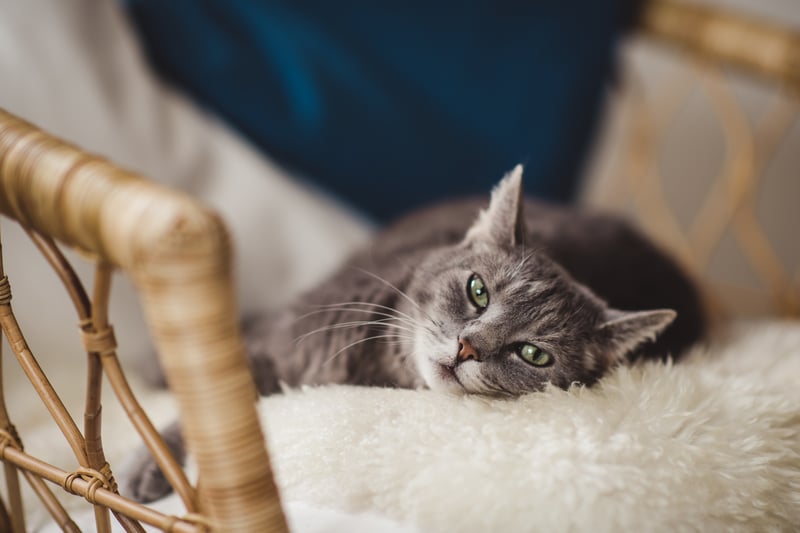
Acupuncture
This is a procedure done by a veterinary acupuncturist. In acupuncture, tiny needles are inserted at particular points in a cat’s body. It works by relieving pressure and muscle tension and causes the cat’s body to release endorphins which as natural pain relief hormones.
Often, acupuncture is used with other cat pain management methods depending on the cause of pain or the extent of the injury. Acupuncture has been known to help relieve pain in cats with arthritis, nerve injuries, and musculoskeletal pain.
Heat/Cold Therapy
A cat with a recent mild injury can benefit from cold pain therapy management. You can wrap a towel in a bag of frozen veggies or ice packs on the affected area. Cold therapy helps reduce pain by numbing the area while reducing inflammation, redness, and swelling. Use cold therapy intermittently for about 30 minutes.
On the other hand, heat therapy works best for a cat recovering from a long-term wound or injury. You can use a hot water bottle and wrap it in a towel or use a heating pad on the affected area. Heat therapy is great for relaxing muscles and boosting blood flow, thus soothing aching and painful joints.
Do not use a cold or hot pack directly on the cat’s coat.
Use Of Supplements
Cat hip and joint supplements containing glucosamine and chondroitin sulfate are good cat joint pain remedies. Combining the two components provides the most beneficial therapeutic effects for cats with painful joints.
Glucosamine contains anti-inflammatory properties that help reduce inflammation as well as inflammation-triggered pain. It also helps joints make more cartilage while protecting the urinary tract and helping alleviate the pain of feline lower urinary tract disease (FLUDT).
Chondroitin sulfate, on the other hand, helps prevent cartilage degeneration caused by diseases like arthritis. A product like TRI-ACTA contains pure active ingredients, including glucosamine, chondroitin, and MSM, to help keep your cats’ joints healthy and mobile.
TRI-ACTA for Pets
A proactive approach for developing and younger adult pets to maintain optimal joint health mobility, minimize inflammation and fend off age-related ailments.
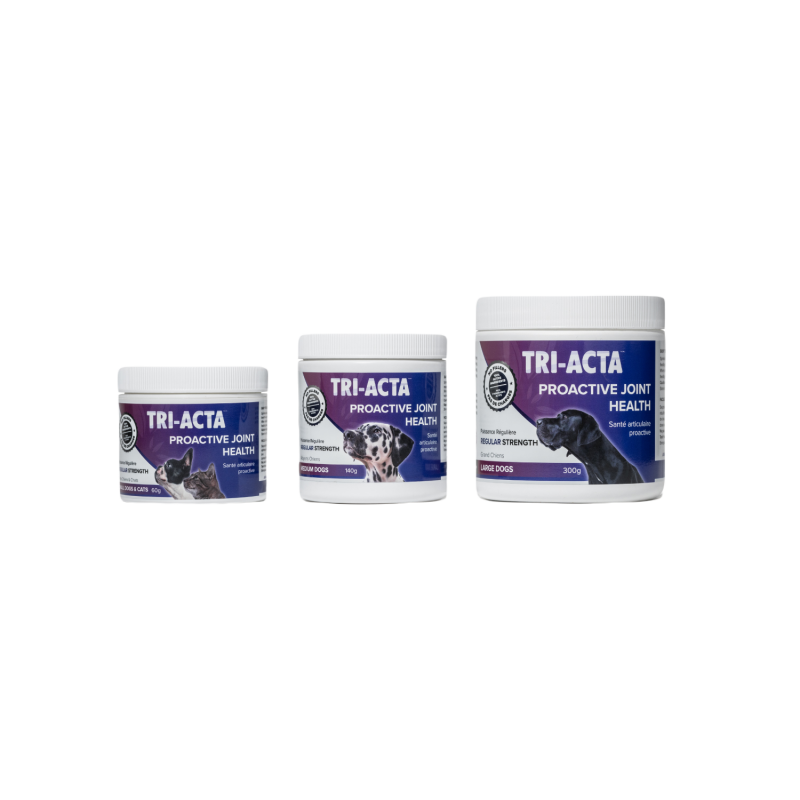
Physical Therapy And Massage
A cat in pain can benefit from physical therapy and even a massage. Performed by a certified rehabilitation practitioner, physical therapy is often recommended for cats with musculoskeletal and neurological ailments. It involves stretching, massaging, and exercising the cat’s joints to help them regain motion, reduce pain, and enhance the range of motion of their joints.
Benefits of physical therapy also include:
- Pain control
- Improved gait for easier, more natural walking
- Enhanced endurance, stamina, and aerobic capacity
A massage, on the other hand, involves kneading of soft tissue and muscle. It can be therapeutic in relieving pain and soreness and helps stretch muscles. It can help restore mobility to an injured limb and enhance movement.
In addition, a massage can help a cat relax and reduce anxiety and stress levels. This in effect, can help soothe aching joints, muscles, and tissue.
Laser Treatment
Laser therapy is a treatment technology that uses light to boost cell repair and growth. It helps with inflammation, muscle relaxation, and promoting injury healing. Laser treatment is beneficial for the treatment of several feline ailments, including
- Ligament and muscle tears
- Cat arthritis
- Wound and pain management
Depending on the extent of the wound or injury, your vet will recommend the number of therapy sessions. They may also include a combination of other cat joint pain remedies for the best outcome for your cat.
Summary
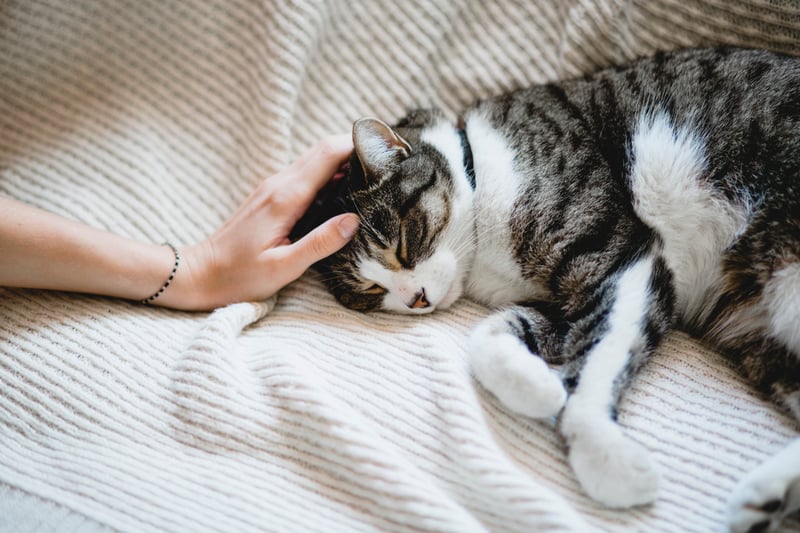
In general, cat pain management is key in keeping your feline feeling their best. Though it is impossible to prevent your kitty from hurting themselves or experiencing pain, having on-hand ready pain remedies can greatly improve the quality of life of your cat. Cat hip and joint care are important in maintaining overall healthy limbs and keeping your kitty lively.
It is important to always be on the lookout for signs that your cat might be in pain. As sneaky as cats can be about their feelings, signs of pain cannot escape the eyes of a keen pet parent. Ultimately, ensure your furbaby is well exercised, feed them a balanced diet, and don't forget to incorporate a cat hip and joint supplement like TRI-ACTA to keep them nimble and sleek.
TRI-ACTA for Pets
A proactive approach for developing and younger adult pets to maintain optimal joint health mobility, minimize inflammation and fend off age-related ailments.

Read more about cat supplement on our resource page and find out how they can help your furbaby live a healthy and happy life.
Newsletter Signup
Subscribe to our newsletter to receive the latest news and exclusive offers.
.jpg?height=2000&name=Cliick_Integricare-DISPLAY-REVISEDV2%20(1).jpg)
Proactive & Therapeutic Joint Supplements
When given daily, Integricare joint supplements recover bone and joint injuries faster and help prevent mobility injuries from happening in the first place.








